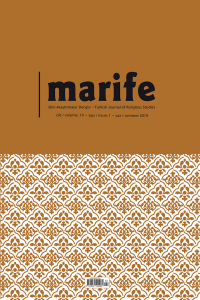
Marife Dini Araştırmalar Dergisi
Yazarlar: Yusuf YURT
Konular:Din Bilimi
DOI:10.33420/marife.769626
Anahtar Kelimeler:Tafsir,Traslation,Anthropomorphic Expressions,Salaf,Khalaf
Özet: In tafsir studies, there is a trend to name some verses by their context. Names such as Sayf, Dhihar, Mubâdalah, Ahkâm are among these different names. This classification is not only based on the context but also the place of revelation, length, the ambiguity of the meaning, and other variables. Per this explanation, there are expressions such as “attribute verses” in Tafsir methodology works. When the verses that are in this category are examined, one can see that these verses do not contain the good attributes of Allah. There are verses in which human and bodily characteristics such as hand, face, eye, coming, wanting, loving, wrath, being in the sky, being on the ground, being on top are attributed to Allah. Verses that contain this kind of expression are called “attribute verses” and those features are called “Sifah al Khabarî”. They are also called Mutashabih because their nature cannot be fully comprehended. Some of the Sifah al Khabarî are included only in the Quran, some in the hadiths, and some in both the Quran and hadiths. In religious texts, these attributes are found in different word forms such as verb, noun, adverb, etc. To elaborate a little more, in said religious texts the expressions that signify emotions like showing mercy, loving, getting angry or expressions that suggest an action such as istiwa, ityan and firagh or words that suggests body parts such as, yed, wajah, ‘ayn are all attributed to Allah. Besides, prepositions that indicate location can also be found in religious texts concerning Allah. Phrases that express being in a place such as “to be in the sky” and “to be on the ground” are also used about Allah. In short, humanly or physical features that in fact cannot be associated with a transcendent being are attributed to Allah in some of the verses. Some of the examples of these attributions/words in ahadith are; finger, feet, to descend, to come, to laugh. A similar name given to the verses is also used for hadiths. Hadiths that contain anthropomorphic expressions are called “attribute hadiths”. Since these expressions in verses and hadiths express being created in terms of their lexical meanings, their attribution to Allah is incompatible with Islam's understanding of divinity. As it is stated in the verses, Allah can’t resemble an entity. There are two approaches to understanding the attribute verses in the Ahl al-Sunnah tradition, which are attributed to the predecessors and the successors. Predecessors indicate the companions of the prophet Muhammad and the generation after them (Tabiin). Before the emergence of creedal sects like Mutazilah, Ashari or Mâturîdî that have their own methodologies, the predecessors’ understanding was dominant Islamic world. Their take on the issue is as follows, “We cannot determine the nature of these verses that include the attributes of Allah. Hence, it is not permissible to talk about this issue.” Those who represent Mâtürîdî and Asharî traditions, who interpret the attribute verses are called successors. Scholars among successors have chosen to follow a milder way than taking the literal meanings of this kind of verses and tried to find an alternative interpretation by considering the Qur’an and Sunnah’s wording style. In other words, they chose to take the meanings of these verses and words metaphorically. In our study, from the Sifah al Khabarî, ityan, medjî, istiwâ, nafs, yed, wajah, ‘ayn and canb were selected as examples. Via the examination of the translation of these words in eleven Qur’an translations produced by individuals or institutions, it is tried to be understood which method was used in the translation of these words to the Turkish language. As a result of our examination of these eleven Qur’an translations, it is seen that the authors of the translations did not just follow one specific method. In these translations, due to the context, sometimes literal meanings were used whereas sometimes interpretative meanings were preferred. It is also evident that in some translations, the Arabic word is written exactly the same in Turkish without translating. To sum up, it is not possible to differentiate the Qur’an translations we examined as predecessor or successor type since the translators did not stick to one method of translation. It may be a better option to call them hybrid translations.